You are wandering through a tropical rainforest. It is late morning and the humidity seems to rise with every step. Life is crawling, buzzing, slithering, climbing, burrowing all around you. Brightly-colored poison dart frogs light up the dark undergrowth like mobile glow-sticks. Fantastic caterpillars, otherworldly insects, ghoulish spiders, tiny scattering creatures. All aspects of nature fascinate you. But you are here for the birds. And there are none. In fact, there have been none for over an hour. The curse of forest birding – a bird drought. You sit down and wait. Maybe the birds will come to you. BZZZUUUZZZZUUUURRR. What was that? Instinctively you cover your face and neck so that you don’t get stung by a giant forest wasp. BZZZUUUZZZZUUUURRR. And then you see it. A hummingbird is hovering a foot from your bright red T-shirt, zigzagging back and forth. Back and forth. You can see from its bill that it is a hermit. A seriously peeved hermit. The giant red tubular flower that is your T-shirt has gotten the better of this blur of fury. Angrily the hermit spins like a tiny attack helicopter and disappears into the darkness.
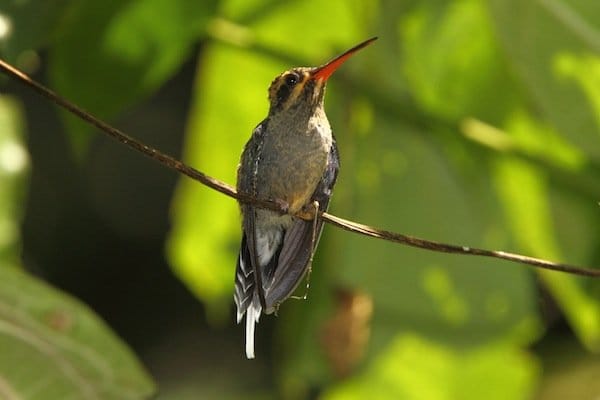 Green Hermit by Adam Riley
Green Hermit by Adam Riley
Hummingbirds are some of the most fascinating creatures known to humankind. They are the only birds able to fly backwards and the 340-odd species come in many different forms. They have unique survival strategies, fantastic colors, crazy bills and endearing personalities. Here is my Top 20 list of the most amazing hummingbirds in the world. Each makes this list because it is literally unbelievable in some aspect of its life whether it be survival, color, shape, size or uniqueness.
NUMBER 20
Starting off the Top 20 list is a tie for 20th place, with both candidates from the good ole US of A. Sharing the 20th berth is Anna’s Hummingbird. The male reaches speeds of over 60 miles per hour (or nearly 400 body lengths per second!!!) during its courtship display dive. This daredevil feat, along with its ridiculous gorget (as illustrated beautifully by Mike below) ensures its spot in the World’s Top 20.
Its partner is the well-known Ruby-throated Hummingbird, one of the only species of hummingbird that migrates every year. For a bird that is only hours from starving to death at any given time, it is no small feat to traverse the 500 miles across the Gulf of Mexico! This gem of a hummingbird does this by doubling its body-weight before each crossing, making it one of the bravest – and hungriest! – hummers on earth.
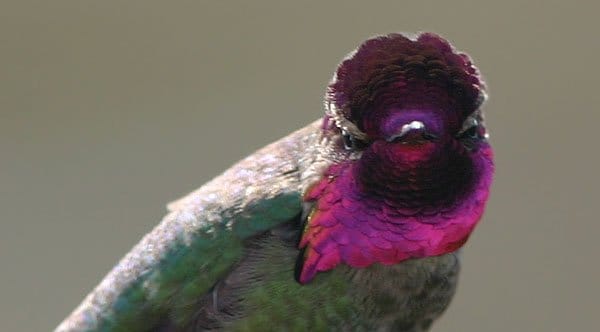 Anna’s Hummingbird by Mike Bergin
Anna’s Hummingbird by Mike Bergin
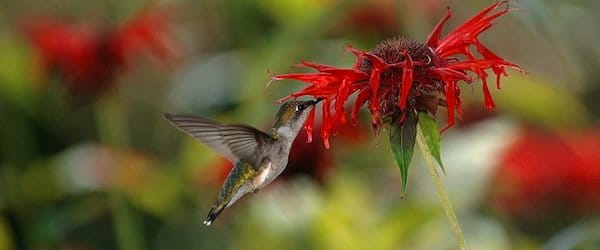 Female Ruby-throated Hummingbird by Joe Schneid
Female Ruby-throated Hummingbird by Joe Schneid
NUMBER 19
The name says it all. Seen under the right light conditions, the Red-tailed Comet has a spectacular red rump and long golden-red tail. As it streaks across the Andean skies of Bolivia and Argentina with its flashy tail, its not hard to see how this bird got the name “comet”. Coming in at no. 19 is the celestial Red-tailed Comet.
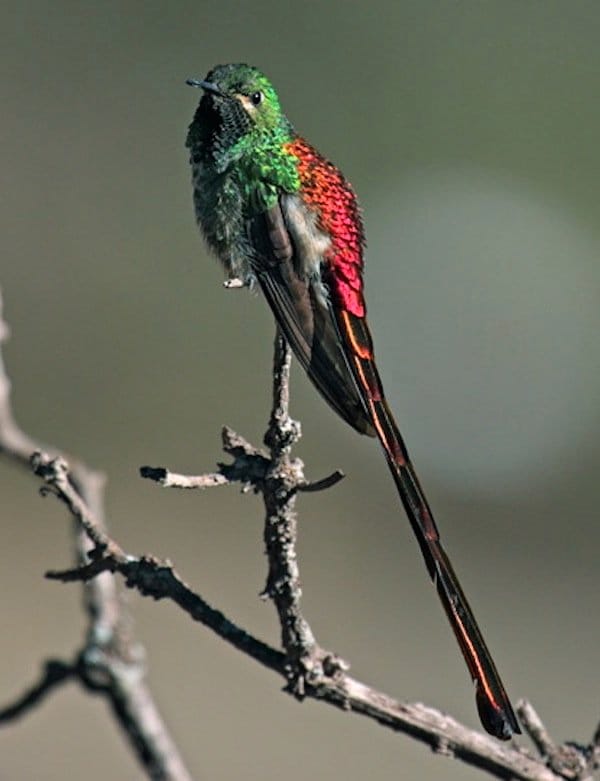 Red-tailed Comet by Nick Athanas
Red-tailed Comet by Nick Athanas
NUMBER 18
The adult male Snowcap is one of the most unmistakable hummingbirds in the world. Found in Costa Rica, Honduras, Panama and Nicaragua, this tiny hummingbird is placed within its own genus microchera. Make sure you watch out for this little stunner if you happen to be in Central America.
NUMBER 17
Holding down the no. 17 spot is the Rainbow-bearded Thornbill. Any hummer with a beard should make this list but this is not just any beard! For this male’s facial whiskers display all the colors of the rainbow to match its bright orange mohawk. These high-flyers from the montane grasslands of Ecuador, Peru and Colombia should not be missed on a trip to these countries.
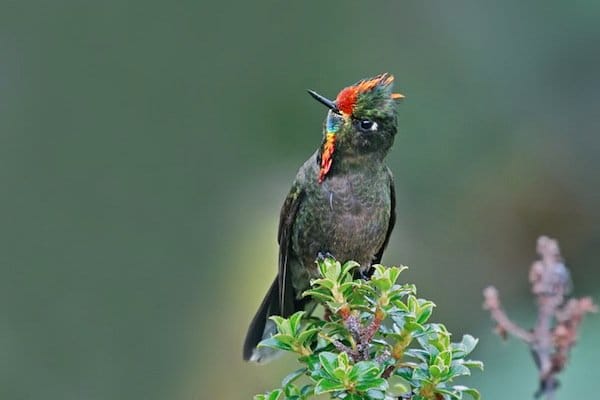 Rainbow-bearded Thornbill by Nick Athanas
Rainbow-bearded Thornbill by Nick Athanas
NUMBER 16
There are a number of hummingbirds with outrageous tails that have made this list. The Swallow-tailed Hummingbird is no exception. One of the largest species of hummingbird with a very unique and un-hummingbird-like tail, it is found in Peru, Bolivia, Brazil and Paraguay where it can actually be remarkably common. It is notorious for its aggressiveness across its range and some birds have been known to attack large mammals and hawks. Fiery personalities are usually accompanied by forked tongues. In this case, the Swallow-tailed Hummingbird lets its forked tail do ALL the talking.
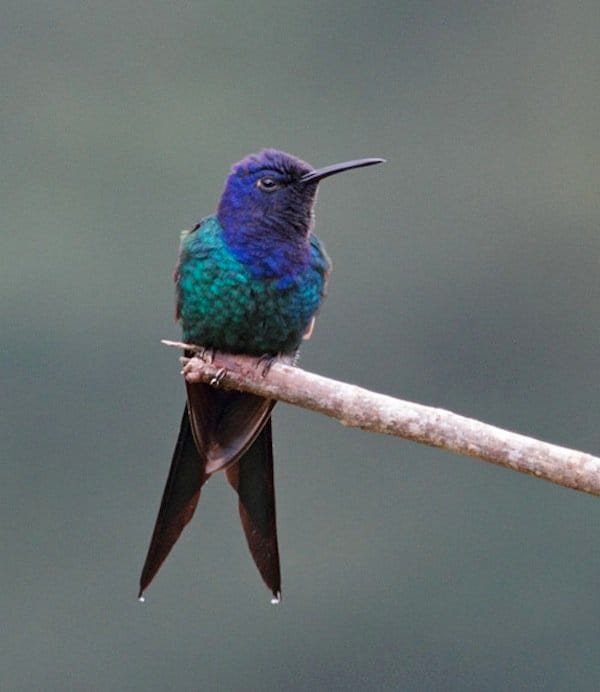 Swallow-tailed Hummingbird by Nick Athanas
Swallow-tailed Hummingbird by Nick Athanas
NUMBER 15
Velvet-purple Coronets are amongst the most photogenic of all hummers. With a dazzling display of colorful feathers and contrasting white retrices, these beauties are a photographer’s dream. Found in the foothills of northern Ecuador and Colombia, these stunning hummingbirds hold down the no. 15 spot on account of their unbridled modeling talent.
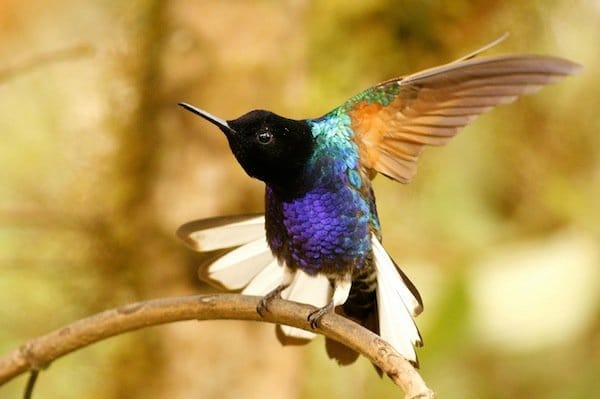 Velvet-purple Coronet by Luke Seitz
Velvet-purple Coronet by Luke Seitz
NUMBER 14
NUMBER 13
There are a few hummingbirds that have truly remarkable bills. The Awlbills and Tooth-billed Hummingbirds are serious contenders for this list and deserve special mention. But, as in the movie Highlander, “THERE CAN BE ONLY ONE!!!”. Ok, no. 3 on this list is also famed for its outrageous beak so let’s stick with “THERE CAN BE ONLY TWO!!!”. And the White-tipped Sicklebill cracks the nod with its totally bizarre eating utensil. Nowhere common, this wonderful hummer is found from Costa Rica to Peru and is a specific pollinator of the heliconia flowers it attends.
NUMBER 12
The Sparkling Violetear occurs commonly throughout much of northern and western South America. Most of the time it simply appears to be a beautiful green hummingbird. But during its display, the males can extend the ear-tufts and this is when it really turns heads! These, the largest of the violetears, hold down the no. 12 spot on account of their sparkling ear-rings.
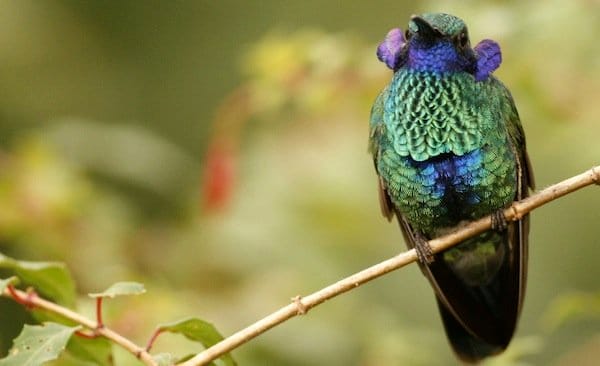 Sparkling Violetear by Luke Seitz
Sparkling Violetear by Luke Seitz
NUMBER 11
One could be forgiven for thinking that Booted Rackettails are fictitious characters from a fairy-tale. Not only do these endearing hummers have some of the craziest tails in the avian world, but they also come complete with cotton-wool balls for feet! Were it not for the fact that these hummingbirds are actually remarkably common at places like Tandayapa Lodge, Ecuador, they would probably be at the top of every birders list. Common or not, these little stunners are not to be missed on a trip to Ecuador, Peru or Colombia.
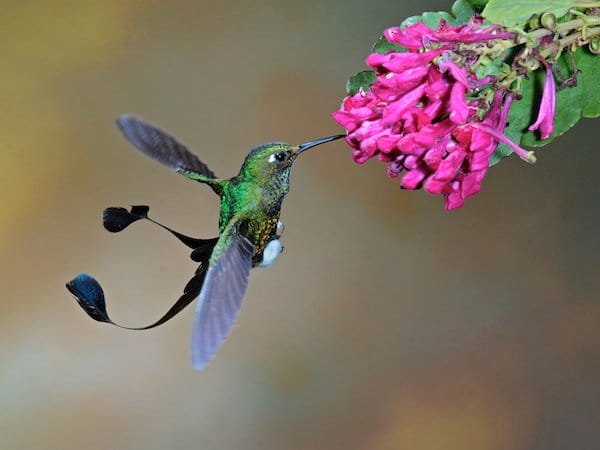 Booted Racket-tail by Sam Woods
Booted Racket-tail by Sam Woods
NUMBER 10
Coming in at no. 10 is the bizarre Bearded Helmetcrest. Found in Colombia and Venezuela and the only member of the genus oxypogon, this freak of nature is not only one of the strangest-looking hummers but it is also one of the most resilient. For the Bearded Helmetcrest spends most of its time above the tree-line in the paramo of the high Andes.
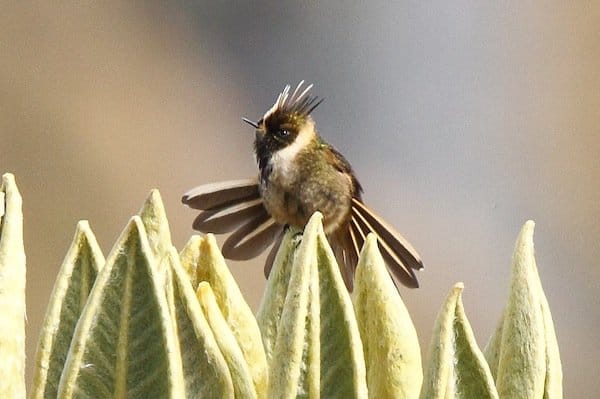 Bearded Helmetcrest by Adam Riley
Bearded Helmetcrest by Adam Riley
NUMBER 9
The names of hummingbirds are arguably the most descriptive for any family of birds. But one name in particular conjures up a particularly strange image…the Black-tailed Trainbearer. A trainbearer is a person who hold the gown of a bride at a wedding procession. But this well-endowed hummer, with one of the longest tail feathers of all the hummingbird species, has to do all the carrying himself.
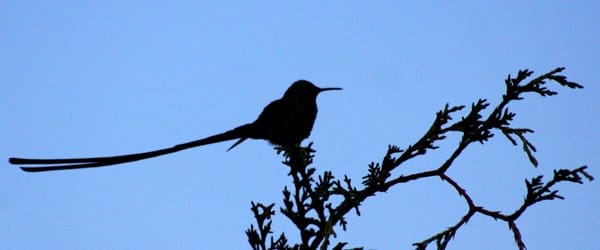 Black-tailed Trainbearer silhouette by Corey Finger
Black-tailed Trainbearer silhouette by Corey Finger
NUMBER 8
The Giant Hummingbird is not colorful. In fact it might just be one of the drabbest hummingbird species out there. But what it lacks in color it makes up for in size. This bruiser is the same size as a Northern Cardinal and the largest hummingbird on earth. Found in the Andes from southwest Colombia to Argentina and Chile, the Giant Hummingbird comes in at no.8.
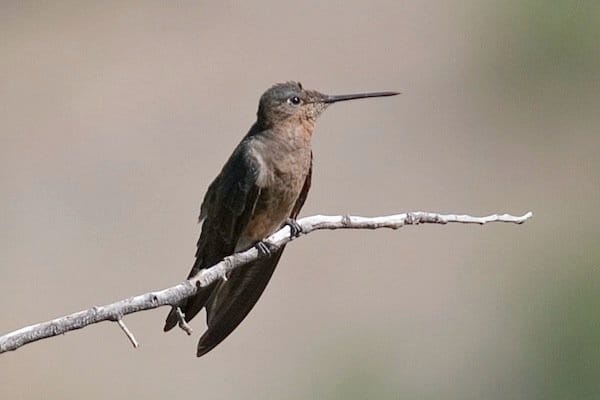 Giant Hummingbird by Arthur Grosset
Giant Hummingbird by Arthur Grosset
NUMBER 7
Not to be outdone by its larger relative at no.8, the insect-sized Bee Hummingbird leaps one spot up due to the fact that this bird is the smallest bird in the world. Found only in Cuba and weighing in at a whopping 1.8 grams, I bet there are many US birders who can’t wait for the travel restrictions to be lifted!
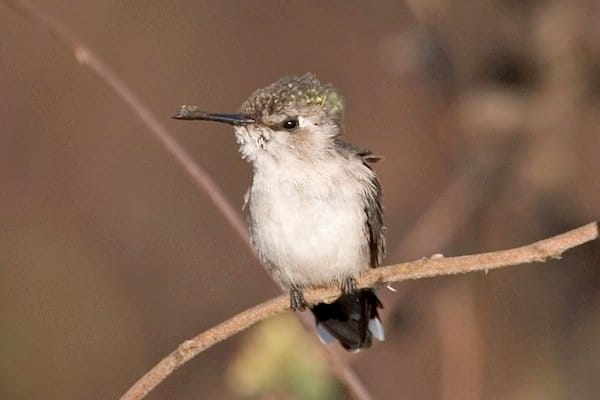 Bee Hummingbird female by Arthur Grosset
Bee Hummingbird female by Arthur Grosset
NUMBER 6
The Crimson Topaz and its closely-related cousin the Fiery Topaz hold down the no. 6 spot. These are thought to be the second-largest of the hummingbirds but their appeal is in their plumage. Found throughout the lowland forests of the Amazon, these hummers are even more beautiful than the gem they are named after.
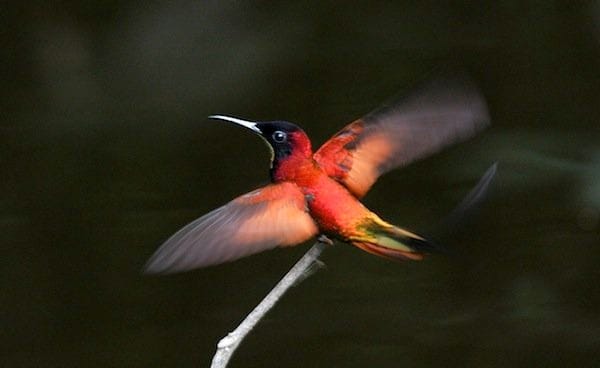 Crimson Topaz by Bird Holidays
Crimson Topaz by Bird Holidays
NUMBER 5
All the coquette species are such remarkable hummingbirds that to single out any particular species would do a serious injustice to the others. These are the punk-rockers of the hummingbird world. And no other hummingbird species can rival the hairstyles of these fire-crackers. According to the dictionary, a coquette is a pretty woman who flirts girlishly, constantly trying to gain the admiration of men. And anyone who has watched coquettes in flight can attest to the suitability of this name. Whether you’re looking at a Rufous-crested, Spangled, Frilled or Black-crested Coquette, you can be sure that the flirting will leave you begging for more.
Rufous-crested Coquette by Carlos Bethancourt
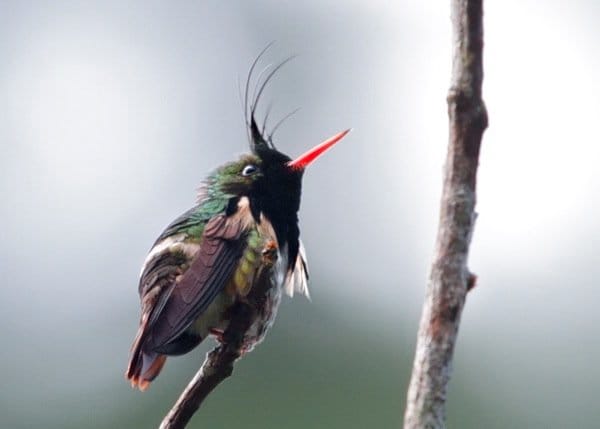 Black-crested Coquette by Nick Athanas
Black-crested Coquette by Nick Athanas
NUMBER 4
So we’ve featured large hummingbirds, small hummingbirds, hummingbirds with long tails, hummingbirds with extraordinary bills and hummingbirds with amazing colors. But the hummer that comes in at number 4 is arguably the toughest hummingbird in the world. The hardy Ecuadorian Hillstar lives higher than any hummingbird on earth and is frequently found way above the treeline at 17,000 feet. This is one of the harshest environments on the planet with freezing temperatures, rarified air and sparse vegetation. Yet this resilient bird is quite at home here.
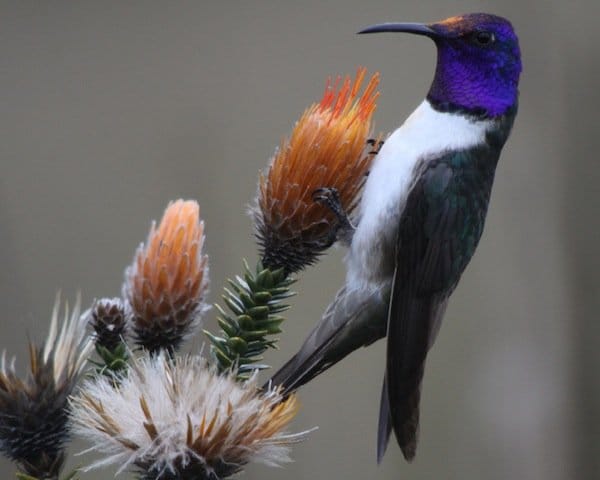 Ecuadorian Hillstar by Corey Finger
Ecuadorian Hillstar by Corey Finger
NUMBER 3
Ensifera ensifera comes from the Latin ensis(sword) and ferre (to wield/carry). This sword-wielder is one of the craziest looking birds in the avian world. The Sword-billed Hummingbird is the only bird in the world whose bill is longer than its body. And its tongue (as illustrated below) is even longer! Can you imagine having such a monstrous bill that you have to groom yourself with your feet! In fact these hummers have been known to hold their bills pointing skyward to avoid neck-strain. The Sword-billed Hummingbird, like our number 4 candidate, is a high altitude hummer and can be found in Bolivia, Colombia, Peru, Ecuador and Venezuela.
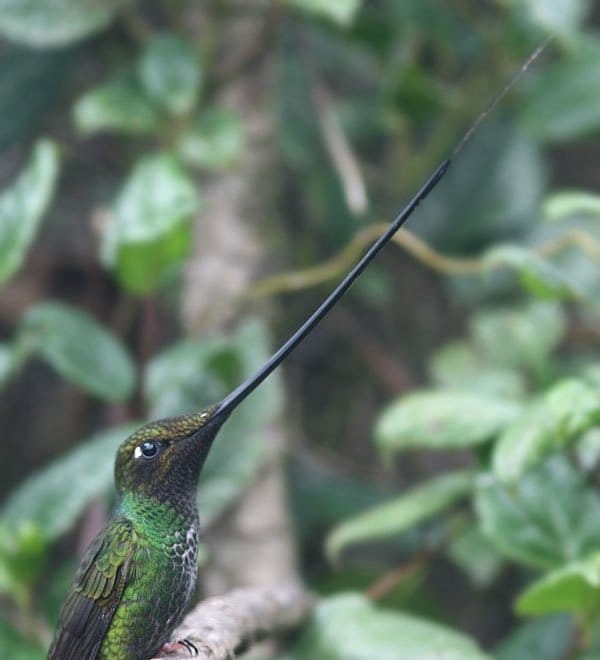 Sword-billed Hummingbird by Mike Bergin
Sword-billed Hummingbird by Mike Bergin
NUMBER 2
One of my favorite birds is the Red-billed Streamertail, Jamaica’s national bird and the inspiration for the national airline’s logo. The Doctorbird, as it is locally called, comes in two flavors, with the black-billed variety being restricted to the extreme east of the island. Although there are several long-tailed hummingbirds, a mature male streamertail has the longest tail appendages of all. With its scissor-like tail, weird crest and bright iridescent coloration, combined with its endemic status, this island hummingbird is right at the top of every hummingbird lover’s list.
A young male Red-billed Streamertail
NUMBER 1
And now…the moment we’ve all been waiting for! It goes without saying that I would be bold to try and place any other hummingbird in the number 1 spot. There is simply no other bird that comes close to rivaling the Marvelous Spatuletail as the most phenomenal hummingbird in the world. Found in the Amazonas region of Peru, this spectacular bird is incredibly rare and localized. But its rarity and good looks are superseded by the male’s awe-inspiring display. Nobody captures this better than the BBC documentary, Life…
httpv://www.youtube.com/watch?v=bnyj1X0ruJk&feature=related
Marvelous Spatuletail by Rich Hoyer
Well, that’s it for the Top 20! Please comment below on what other hummers you think should be on this list. Visit the Arthur Grosset and Nick Athanas sites for great hummer pics. Watch the following Nikon’s BATV videos for great hummingbird videos:
httpv://www.youtube.com/watch?v=A7LnMhqN_SQ
httpv://www.youtube.com/watch?v=J8aUrB5FWUE
httpv://www.youtube.com/watch?v=iVYAWWSuJfY


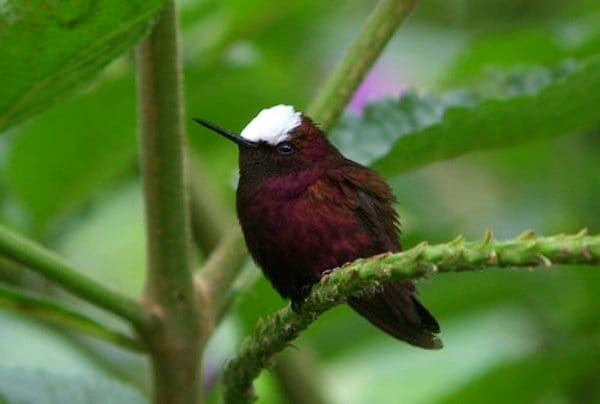
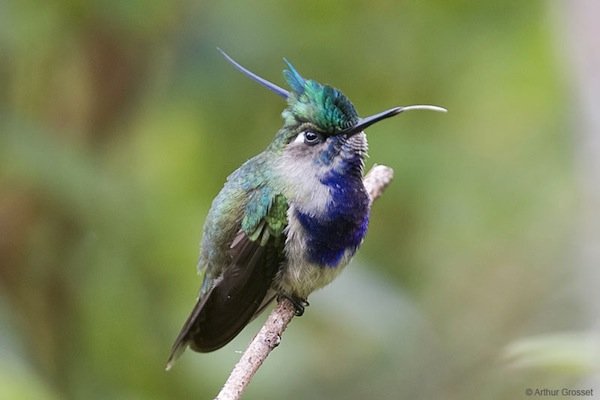
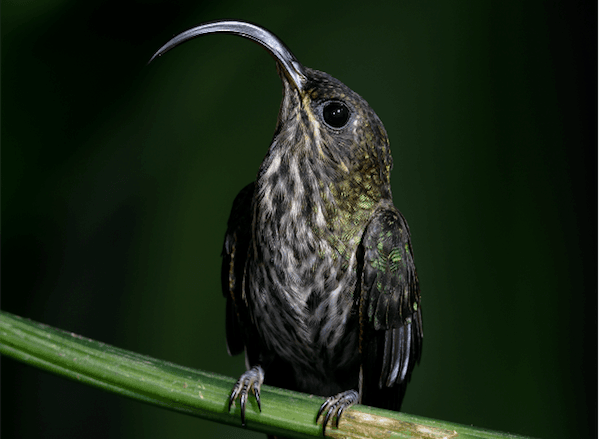
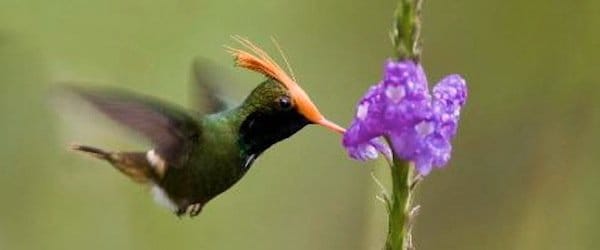
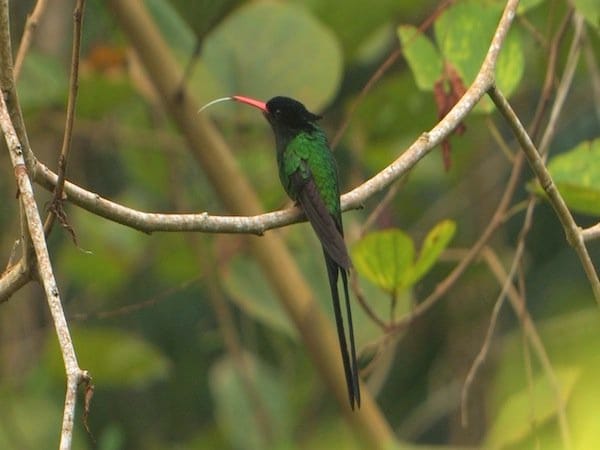
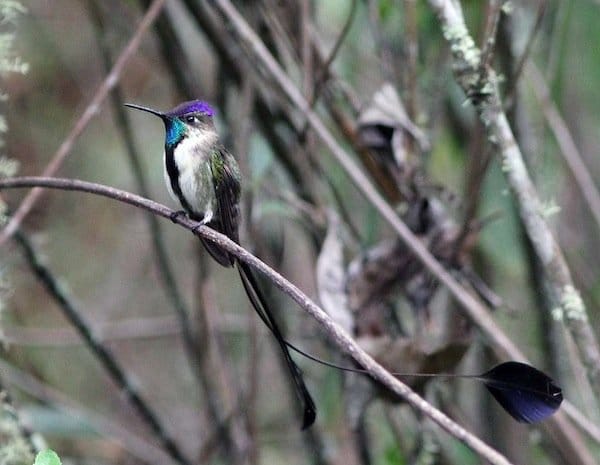











Wow. Speechless….wow.
Wow! I better not die anytime soon..I have many hummers to see. Great post.
Fabulous video, thank you so much!
So. Many. Hummingbirds.
This post is disgustingly good and should be immediately censored so as to prevent too many people from becoming birders.
I’m with Ed Byrne, who says of such lists “It’s quite a morbid way of presenting what should be quite a jolly thing. It’s not “here’s twenty great things you should do” it’s “twenty things to do before you DIE! Come on, clocks ticking”.
I’m at one at that list. But I havent got many hummingbirds period. I do have some exceptional sunbirds and honeyeaters though.
Wow! The hummingbirds we have in SE Arizona are all amazing, but these are mind-boggling. Fantastic post!
Thought I just commented here, but must have pressed Reset rather than Submit. Anyway, great list and concept for a blogpost James. I totally agree with your number one. Got one on my cap on my profile pic.
Although I have not seen any of the doctorbirds, I did not think it really qualified as number two, until I did a google search and found this: http://farm5.static.flickr.com/4039/4477270044_5e1337946f.jpg
Other wise I really like Great Sapphirewing and Wire-crested Thorntail. And even the common Fork-tailed Woodnymph is extremely pretty.
I found a nice gallery with lots of hummers from Ecuador. http://www.briccettiphoto.com/show/galleries?id=72157624581488484
If anyone wants to see the lek of the Marvelous Spatuletail, the best months are between November and April.
@Duncan: Top 20 Sunbirds would be a good one!
@Gunnar: My image is of a young bird. The one you found REALLY shows off the bird in all its splendor! Great Sapphirewing is a serious contender for this list too. I also like Gould’s Inca.
Great post! I have been lucky enough to see most of these hummingbirds, as I am also fascinated with them. There are a couple on the list I have not been able to see….yet. Lovely photos to go with it!
This is such a great post. I really love watching the hummingbirds, and though I’ve seen quite a few I have a long way to go. Thanks for the descriptions and photos, they are AWESOME!
Good luck seeing them all Sharon!
@Debbie: Thanks! I suppose the one bonus is that they are all found in the Western hemisphere so less traveling!
James they’re gorgeous…I wish humans were so interesting =)
@Sandy: I think we pale in comparison!
Nice post. It makes me think though of the great hummers that didn’t make the list. It must have been tough to pick just 20!
@Luke: I can easily think of another 20. Some great hummers that were tough to leave off the list were Violet-tailed Sylph, Green-crowned Woodnymph, Gould’s Inca to name but a few. A Top 50 might have been easier!
James, this post is EPIC. Congrats to you for your bravery and taste in making extremely tough calls in distilling the awesomeness of the entire hummingbird family down to just 20 unforgettable birds!
In defense of the Streamertail’s lofty place, one should note that the Doctor Bird comes in two flavors (Red-billed and Black-billed) and is the symbol for Air Jamaica.
Great Sapphirewing is a big beauty of a hummingbird. Here are some shots of that species with a few more stunners at Yanacocha: http://10000birds.com/hummingbirds-of-yanacocha.htm
Fans of hummingbirds will enjoy browsing through all of our hummingbird posts, especially the more recent ones published after we read the bloody manuals for our cameras!
And you’ll find a fair photo of Violet-tailed Sylph in our Hummingbirds of Refugio Paz De Las Aves gallery!
@Mike: Thanks for the additional info and links to these stunners.
This post could really be expanded into a nice little book. My favorite is the Black-tailed Trainbearer ’cause it is a fairly common bird in Quito. I love the idea of walking in the middle of that busy city and seeing this stunning creature flying into a tree right next to you.
I vote for the addition of Violet-tailed Sylph to this list, but that may be because my views of it in Mindo were so tantalizing and I can’t wait to go back to Ecuador to see more.
Best post for 2011! Talk about eye candy! Great summary of such a tough list to make since just about every hummingbird species is breathtaking.
@Donna: I would have to agree re the sylph. I was fortunate to have a male in the hand in Eucador – so beautiful!
@ Pat: Thanks for your comment. Agree – it really should be a Top 350!
What about Juan Fernandez Firecrown? One of the rarest and most unique of all hummingbirds. And spectacular as well!
@Andrew: Great suggestion! Here’s a good link about this rare hummer.
Nice post James, glad to see you blogging here, I met you on a filming trip on Monterey Bay last year.
I like the list, but where is the Juan Fernandez Firecrown?! Critically endangered island endemic hummer! And not some little nearshore island, but Robinson Crusoe, 350mi from S. America! That gets my vote, for no other reason than excuse to visit such an incredible archipelago.
hah, read the above comment! Glad to know I’m not alone.
@Abe: Great to hear from you again. No, you are certainly not alone. Beautiful bird and thanks for pointing it out!
Having seen only 6 of them, there are many too go at. It´s hard to question no.1, and that will be the one I´ll be looking for next time I get to South America, which unfortunately is quite expensive when living in Europe. I would have fancied to see the Booted Racketail much further up the list. I miss the Fiery throated hummingbird on the list.
thanks for such a great treat! It must have been difficult to limit the list to 20…. so many hummers, so little time!
@Jean: Too true! A top 100 would have been easier…
Where’s the Great Sapphirewing and Violet-Tailed Sylph??
Otherwise, nice selection, although just picking 20 is a futile exercise.
James – this is awesome! These hummers are worthy of the top 20, but every single hummingbird is on my “bucket list”! I can’t wait to book a trip to Tandayapa Lodge. Having visited Canopy Tower and Lodge in June, we saw 23 species of hummers and I loved to see the video as it brought back memories of a great trip! Thanks for these videos!
Peggy
@Peggy: Awesome Peggy! You won’t be disappointed with Tandayapa – its simply spectacular!
Hey James,
great list! Several to go still, but what about the starfrontlets, especially rainbow SF and the incredible dusky starfrontlet. Also, very partial to glowing puffleg, wire-crested thorntail and the horned sungem!
Cheers,
filip
@Filip: Love your suggestions, especially Rainbow Starfrontlet and Horned Sungem. Thanks for contributing!
your fotos are spectacular & i,ve been thrilled 2 look thru them & the interesting info made in comments,i was lucky 2visit rocklands bird sanctuary in jamaica & the doctor birds fly in & feed from ur bottle of nectar,my 1st encounter with hummingbirds,AWESOME!!!!!costa rica was fabulous & I saw many & took fotos{only amateur ones}thanx 4 this site its been an inspiration 4 me 2 see many more.
your fotos are spectacular,i was lucky 2visit jamaica & hav fotos & footage of the doctor bird & of many in costa rica,the violet sabrewing & green thorntail were my faves.
A true a visual treat…thank you!!!!
I would go out with a smile on my face.
I’d add Colombia’s Colorful Puffleg, apparently one of and possibly the most range-restricted bird species in the world, and it’s not even an islander. It’s little booties are quite unique looking too.
Fantastic hummers! I’d love to see posts of great lodges to see hummingbirds in addition to the Ecuadorian ones and Panama’s. Can anybody make some other suggestions? our knees aren’t getting any younger and we need some easy vacation destinations rich in hummingbirds.
Love the shots of the hummingbirds! I feed migratory ones every spring and summer and am looking for the best food possible for them. Colorado Rockies can be harsh, with killer hail often. And so
I need a suggestion on the best formula. Any thoughts would be appreciated… Thanks, lani